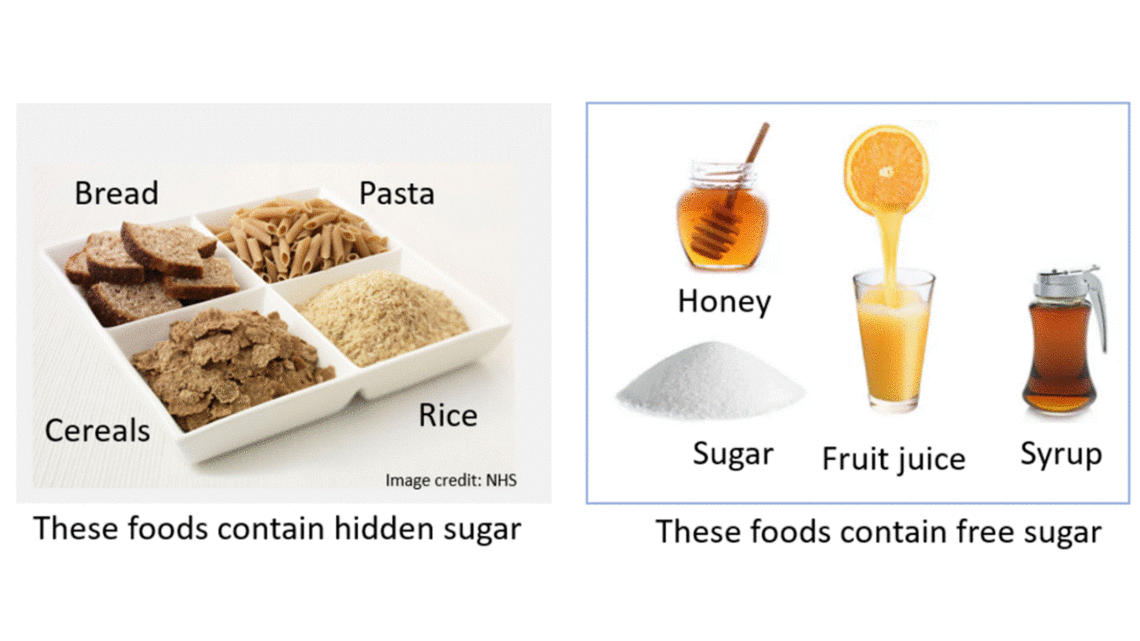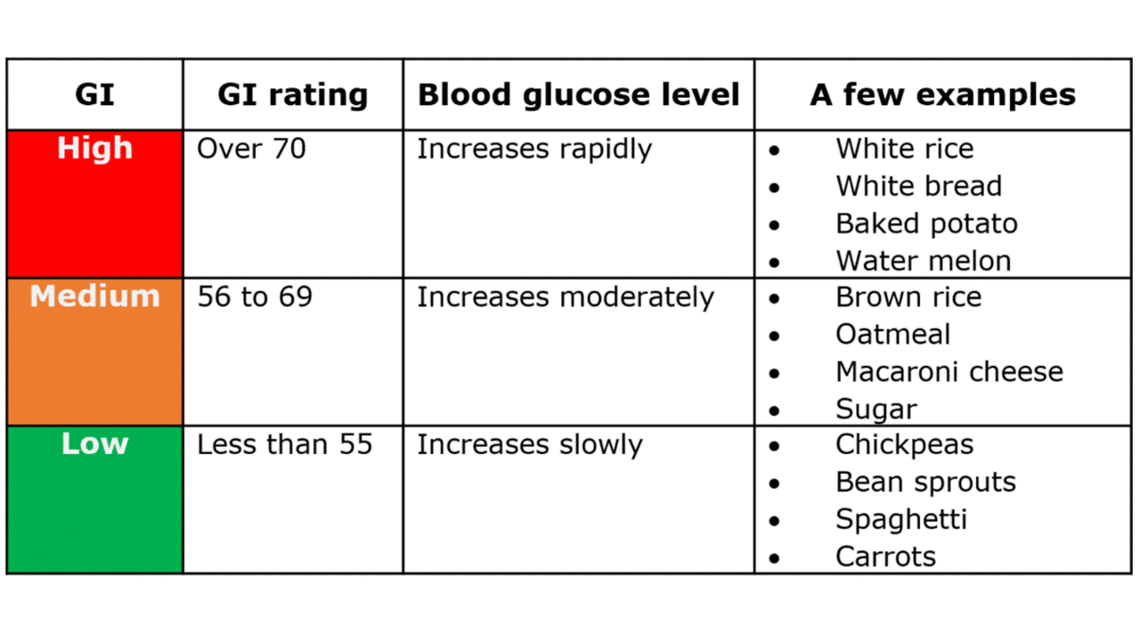What are they? Why do they matter? How can they help us make healthier food choices?
- Carbohydrates, sugar, insulin and diabetes
- Which foods contain carbohydrates?
- The glycemic measures: GI and GL
- So, what foods should I eat?
- And what foods should I eat less of?
- What diseases or illnesses might a low GI/GL diet help protect against?
- Conclusions
Carbohydrates, sugar, insulin and diabetes
When we eat food containing carbohydrates, such as bread, potatoes, rice and pasta, our digestive system breaks down the digestible carbohydrates into sugar, which then enters our blood and gives us energy.
When our blood sugar level spikes, the pancreas – located near the stomach – releases extra insulin to lower it. If extra insulin is required regularly, for instance if we take in too much sugar too often in our diet, the pancreas produces too much insulin which may then result in ‘insulin resistance’. This resistance can potentially lead to diabetes, especially in families where there is already a history of the illness. Diabetes can in turn increase other health risks, like stroke and heart attack.
|
We shouldn’t stop eating carbohydrates –they are an important part of a balanced diet. |
We need to try to:
- eat more ‘good carbs’, such as whole grain cereal, fruits, vegetables and wholemeal products.
- eat fewer ‘bad carbs’, such as free sugars, refined cereals and sweetened beverages.
Which foods contain carbohydrates?
Carbohydrates provide energy for our body and are found in many types of food, including:
- Starchy foods like rice, noodles, pasta, yam, potatoes and cereals
- Sugar, sweetened drinks and other sweet foods
- Crisps, pies, biscuits, cakes and pastries
- Dairy products such as milk and yogurt
- Fruit and fruit juices
All these foods contain carbohydrates either as hidden sugar (‘intrinsic sugar’) like bread, potatoes, milk and cereals, or as free sugar (‘extrinsic sugar’) such as honey, sugar syrup, fruit juice or ordinary sugar.

We can measure our ‘glycemic response’ to food – the effect that food has on our blood sugar levels – using the Glycemic Index (GI) and Glycemic Load (GL). Both measures can help us manage our diet and reduce the risk of diabetes.
Glycemic Index (GI)
GI is a value between 0 and 100 (glucose = 100) that shows us whether a food raises blood glucose levels quickly, moderately or slowly after we’ve eaten it.
Based on their GI value, foods are classified into three categories:

Food is likely to have a higher GI if it has been processed or refined, if it has been finely ground, if it has a low fibre content and if (in the case of fruit and vegetables) they are ripe.
Glycemic Load (GL)
Research suggests that it is the amount of carbohydrate (the load) you eat, rather than its GI rating, which has the biggest effect on blood glucose levels after a meal. The Glycemic Load (GL) measure includes not only how much carbohydrate there is in a portion of food but also the GI of that food.
|
GL is probably a more reliable indicator of how quickly a particular food is likely to raise blood glucose levels. |
So, what foods should I eat?
Examples of foods with low to moderate GI and GL.
*Fruits from warmer countries tend to have a higher GI and medium GL, but oranges and grapefruits have low levels.
Some foods have a high or medium GI but a low GL, so the recommendation is to eat them in moderation as part of a balanced diet; for example, watermelon (high GI) and couscous (medium GI).
And what foods should I eat less of?
Try to eat less white rice, fewer potatoes without skins (potato skins are a good source of fibre) or old potatoes, and try to eat fewer doughnuts, bagels and pizza. All of these foods have high GI and high GL.
|
Useful tip: The amount of carbohydrate you eat has more of an effect on your blood glucose levels than the GI of the food alone. Diabetes UK |
You might have noticed that (with the possible exception of red meat) most low GI/low GL foods are also ones that appear regularly on lists of the kind of foods to include in a healthy diet. The fact that they are also low GI and low GL is an added bonus.
What diseases or illnesses might a low GI/GL diet help protect against?
Changing to a regular low GI/GL diet can help protect you against several diseases and illnesses:
Type 2 diabetes: Studies show that a low GL diet is associated with a significantly lower risk of type 2 diabetes.
Cardiovascular diseases: Foods that cause a higher glycemic response are associated with a high risk of coronary heart disease. However, studies suggest that, in order to reduce the risk of cardiovascular diseases, it is important to have a healthy diet rather than concentrating only on the glycemic response.
Obesity: It has been suggested that a low GI/GL diet helps you feel fuller for longer. This means that you’re less likely to overeat and become obese, although research findings here are mixed.
Some cancers: A large study published in 2019 concluded that food with low GI and low GL are associated with reduced risk of colorectal, kidney, bladder and endometrial cancer.
Reduced total cholesterol and LDL (‘bad cholesterol’): According to the review of available studies, a fibre-rich diet of low GI foods is associated with a reduction in LDL-cholesterol, but has no significant effect on levels of HDL-cholesterol.
Conclusions
- A healthy, balanced diet is likely to contain many foods with low GLs.
- GL is a more realistic measure than GI of how foods affect our sugar levels, as it includes the amount of carbohydrate/s we consume in a meal.
- Typical low GI/GL foods include most vegetables and fruits that grow in the UK, as well as pulses, fish, nuts and dairy or soya milk.
- A low GL diet is associated with a reduced risk of type 2 diabetes, stroke, obesity, some cancers and coronary heart disease.
- A low GI diet may help reduce LDL-cholesterol.
__________________________
Other relevant articles on the Age Watch website:
- Diet: Diet
- Diet: Healthy foods
- Diet: Healthy eating on a budget
- Diet: Cruciferous vegetables – kale, cabbage and broccoli
- Diet: Nutritional value of Top 20 foods
- Diet: Vegetarian diet
- Illnesses: Type 2 diabetes
- Tackling obesity: Are carbs really bad for your diet
Reviewed and updated by Kirulagini Sivamathavan, September 2020. Next review date August 2024

